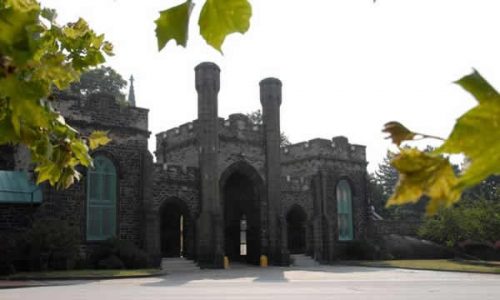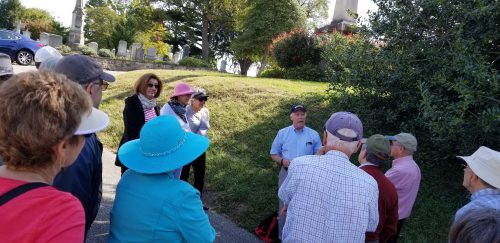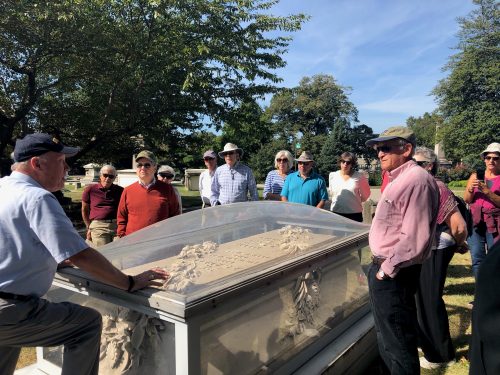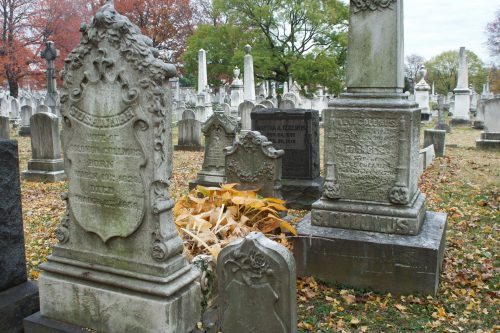Volunteers Visit the Green Mount Cemetery

A blog post from JMM Volunteer Coordinator Wendy Davis. To read more posts from Wendy, click here.

On a beautiful Friday morning in September, we drove through the Tudor/Gothic-styled and imposing entrance gate designed by Robert Cary Long, Jr. Yes, he IS the same man who was the architect for the Lloyd Street Synagogue!

We learned that when the cemetery was developed in 1838, it was located outside the city limits on property called “Green Mount” previously owned by the merchant Robert Oliver (hence the name of nearby Oliver Street). The cemetery was designed by Benjamin Henry Latrobe II as a rural garden cemetery, with winding paths and gardens. Did you know that the original rural garden cemetery was in Paris – the Pere Lachaise? The first rural garden cemetery in the United States was Mount Auburn in Cambridge, Massachusetts, established 7 years prior to Green Mount Cemetery. These cemeteries were such beautiful locations that many spent time picnicking there. They were also early prototypes for large urban parks like Central Park in NYC and Druid Hill Park in Baltimore.

The most infamous is John Wilkes Booth, who is buried in an unmarked grave in his family’s plot. There were many more famous people interned there, from US senators and congressmen to Maryland governors to Civil War officers from both the Union and the Confederate armies. The names we easily recognized were Betsey Patterson Bonaparte (Once married to Joseph Bonaparte, but Napoleon wanted his brother to marry royalty, so they divorced. Betsey was rewarded with a stipend, making her the richest woman in Baltimore.), A.S. Abell, founder of the Baltimore Sun Paper (in a beautifully carved sarcophagus), Johns Hopkins, Mary Elizabeth Garrett, who funded the Johns Hopkins University Medical School with the stipulation that women would be admitted on the same basis as men, Henry Walters, Enoch Pratt, and Mayor Theodore R. McKeldin.

When I originally spoke with Wayne, he did not know of any Jews buried in the cemetery. But as fate would have it, five days before our tour he learned of Levi Collmus, the second Bohemian Jew in Maryland. Levi Collmus arrived in Baltimore from Prague in 1806 and was a defender at Ft. McHenry along with five other Jews in 1814. He was a member of the minyan that petitioned the Maryland legislature for a charter that would permit them to establish a synagogue. As a result of those efforts, Nidhei Israel/Baltimore Hebrew Congregation, the builder of the Lloyd Street Synagogue, was incorporated. There is a record dated Oct.6th, 1846 of Levi Collmus paying $50 for seats in the “New Synagogue.”
Levi Collmus was also a founder and treasurer of the United Hebrew Benevolent Society of Baltimore in 1834. According to Isaac M. Fein, the organization was Baltimore’s first non-synagogue Jewish organization. A note from the Collmus family mentioned that Levi Collmus married a Quaker, Frances Ann Williams “because there were no Hebrew girls to marry” in 1812.

We JMM volunteers agreed that we had a fascinating fall morning learning about who’s who in Baltimore history and about one of the founders of the Baltimore Jewish community. Now I can check visiting the Green Mount Cemetery off my bucket list, BUT I want to go back to further explore this urban garden!
